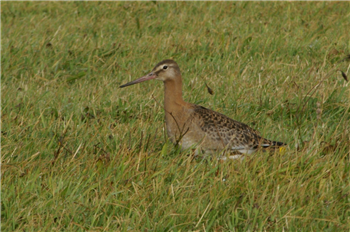A Ranger Writes: wading birds
Our Countryside Rangers have a wealth of knowledge on the places, plants and species that call East Lothian Home. Ranger Richard English offers some insights into wading birds and explains why these elegant birds are worth looking out for.
We’re fortunate in East Lothian to have coastal areas and river estuaries that provide great habitats for wildlife. These habitats are exploited by all manner of species – plants, animals and fungi. Better minds than mine will also be able to point to the many millions of single-celled organisms that thrive in these areas, but that’s a bit beyond the scope of this humble column.
'Summer finery'
 A Barwit. Image by Ian Andrew
A Barwit. Image by Ian Andrew
Wading birds, or waders, are a common sight along the coast, particularly near the mouths of the Esk, Peffer Burn and Tyne. As the name suggests, these birds spend much of their time in shallow water, or on mudflats, seeking out the rich and varied food resources found there. At this time of year, it’s worth looking out for waders that are still in their summer plumage, having recently returned from their breeding grounds. Winter plumage waders are generally a rather drab bunch, but in their summer finery they can be spectacular.
Godwits are a group of waders which consist of only four species worldwide. Two of these, the marbled and Hudsonian godwits are found in the Americas, but the other two are regular visitors to East Lothian. Both of these species, the bar-tailed and black-tailed godwits, are long-legged, long-billed birds. They can be tricky to tell apart, but at least they’re fairly easy to distinguish from other waders.
 Blackwit photographed by Mike Pennington
Blackwit photographed by Mike Pennington
The bar-tailed godwit is the more common of the two – it’s not unusual to see flocks of several hundred at a time. They breed in Scandinavia and northern Russia, but will pass through the UK during spring and autumn migration, and many will over-winter on our coast. By contrast, black-tailed godwits have a (very) small breeding population in England, but in this part of the country they’re only really seen as migrants passing through on their way south from Iceland.
Dramatic plumage
One of the main distinguishing features between the species is, not surprisingly, the pattern of the tail. In the bar-tailed godwit, the tail feathers form a series of dark and light bars (yes, it’s that simple), topped by a long white wedge that runs up the bird’s back. The black-tailed version has a single broad black band on the tail, with a noticeable white square above it. The latter also has white wing bars which are very obvious in flight. In summer, both species have dramatic orange-red plumage about their throat and chest, but this fades as autumn approaches. In winter both species appear grey-brown, although the bar-tailed godwit shows more streaking on its head, neck and back. The black-tailed tends to be a much more uniform grey.
The genus name for godwits is Limosa, derived from the Latin limus, meaning mud, reflecting the birds’ preferred feeding habitat. Godwit itself may be imitative of the bird’s call, although an alternative derivation is from the Anglo-Saxon god and whita, indicating an animal that is good to eat. Whatever the source of the name, both of these godwit species are attractive and elegant parts of our local wildlife and well worth searching out.
More on our Countryside Rangers
Meet Robbie! Find out more about a Ranger's role in summer season and what an average day looks like (spoiler: there's no such thing).